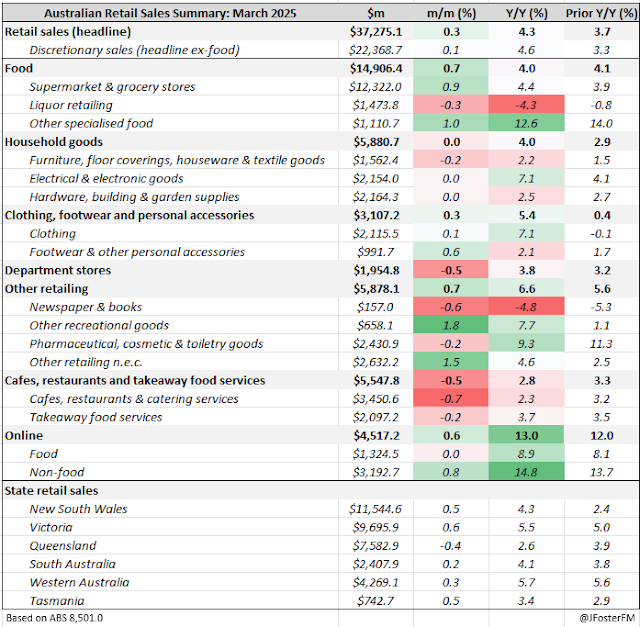Australian retail sales posted a modest 0.3% rise in March (4.3%yr), slightly missing expectations (0.4%) as the disruptions of ex-Tropical Cyclone Alfred dented sales in Queensland (-0.4%). After rising by 1.3% through the back half of last year, growth in underlying volumes - sales adjusted for inflation - stalled in the March quarter, well short of the 0.3% consensus forecast. Consistent with the Q1 CPI report released earlier this week, retail prices ticked back up in the quarter rising by 0.7%. A soft picture of consumer demand in today's report keeps the RBA on track to cut in May.
Retail sales nationally increased by 0.3% for the month in March. This was driven by food sales (0.7%) on stockpiling effects in preparation for ex-Tropical Cyclone Alfred, which affected south east Queensland and northern New South Wales. Supermarket sales rose by 0.9% nationwide on the back of a 1.9% surge in Queensland - the fastest rise in the state since the Covid restrictions in 2021.
But despite this boost, sales in Queensland actually fell in March (-0.4%) - the only state that saw sales decline in the month - due to the overall disruptions caused by the cyclone, shuttering businesses and keeping people at home.
Back to a national perspective, in addition to the rise in food sales, category gains were also posted in clothing and footwear (0.3%) and other retailing (0.7%). Turnover was flat in household goods (0%) while it declined in department stores (-0.5%) and at restaurants and cafes (-0.5%).
Following the gain in March, retail turnover was up by 0.7% across the first quarter of the year - a solid gain but down from the increases in the low 1s in the past two quarters (1.1% in Q3 and 1.3% in Q4). However, unlike in those two quarters where underlying volume demand increased (0.5% in Q3 and 0.8% in Q4), it stalled (0%) in this latest quarter. That left the growth in nominal sales in Q1 being driven entirely by a 0.7% uplift in prices. Higher prices were driven by food (1%q/q) and dining out (0.8%q/q), consistent with the Q1 CPI report.
Volume growth in Q1 was weighed by a sizeable decline in household goods (-1.9%), its weakest outturn in nearly two years, and from households pulling back from dining out (-0.1%). These outcomes offset gains that came through in department stores (2.3%), clothing and footwear (1.5%), other retailing (0.7%) and food (0.4%).








